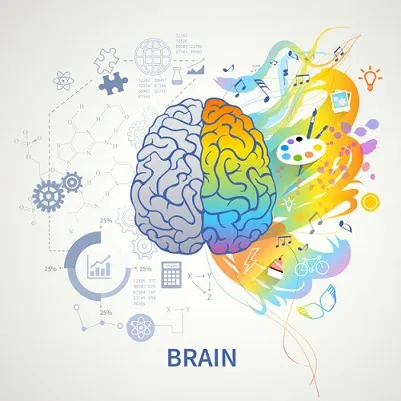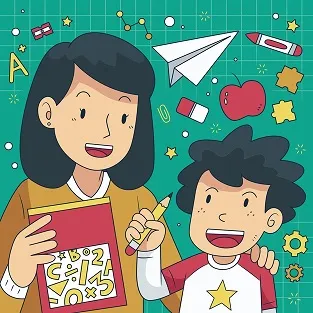
Source: freepik.es
Una de las sensaciones más frustrantes que puede sentir una persona es de la pensar que no cuenta con las capacidades y habilidades para ayudar a otros, en el proceso educativo pasa exactamente lo mismo cuando nos enfrentamos a la educación en casa y a las tareas escolares de nuestros hijos. Muchos padres señalan sentirse incapaces de ayudar a sus hijos en el proceso de aprendizaje de algún contenido, el desarrollo de una actividad o la resolución de algún problema por el hecho de no comprender cómo hacer y que estrategias usar.
In this post we are going to know the types of learning through which people become owners of knowledge, this will help us to understand how our children learn and what are the right tools or strategies when it is our turn as parents to assume the role of the teacher. Let us remember that teachers study pedagogy and there they learn the theories of learning that allow them to exercise their function of teaching according to the capacities, attitudes and aptitudes as well as potentialities presented by the students.
En este post vamos a conocer los tipos de aprendizaje a través de los cuales las personas nos hacemos dueños del saber, esto nos ayudará a entender como aprenden nuestros hijos y cuáles son las herramientas o estrategias adecuadas cuando nos toca a nosotros como padres asumir el rol del docente. Recordemos que los docentes estudian pedagogía y allí aprenden las teorías del aprendizaje que les permiten ejercer su función de enseñar según las capacidades, actitudes y aptitudes así como potencialidades presentan los estudiantes.
We must also understand that we do not all learn in the same way, and although your children all have the same blood and genetic load in terms of cognitive, psychological, behavioural, sentimental and many other things, each one is different. That is why what we must bear in mind in the first place is never to compare the way each of our children learn, because each one, as an individual, has a process and a way of approaching knowledge.
De igual manera debemos comprender que no todos aprendemos de la misma forma y aunque sus hijos lleven todos la misma sangre y carga genética en lo que se refiere al aspecto cognitivo, psicológico, conductual, sentimental y muchas otras cosas más cada uno es diferente. Por eso lo que debemos tener presente en primer lugar nunca debe comparar la forma de aprender que tiene cada uno de nuestros hijos, pues cada uno, como individuo tiene un proceso y una forma de acercarse al conocimiento.
It is extremely important to recognise whether our children are auditory, visual or kinaesthetic learners, which will allow us to help them and create appropriate strategies for their learning:

Source: freepik.es
Algo sumamente importante es reconocer si nuestros hijos tienen un aprendizaje auditivo, visual o kinestésico eso nos permitirá ayudarlos y crear las estrategias adecuadas para su aprendizaje:
Auditory: You may have noticed that your child is one of those children who likes to read aloud when he is memorising or learning a subject, that when adding, subtracting, multiplying or performing any mathematical operation he has to name each step of the process or that he asks you to read and explain to him what he has to learn. Parents we are dealing with a person whose learning is auditory and depends on hearing and attentive listening. With them, the ideal is to allow them to study out loud, that we dictate or read what they must memorise. A significant strategy that has given me a lot of results with auditory learners is to record the classes or explanations so that they can listen to them as many times as necessary. Silence is frightening for them and does not facilitate learning. It is also very helpful to play music at low volume to help them concentrate.
Auditivo: Quizá haya notado que su hijo es de esos niños que les gusta leer en voz alta cuando está memorizando o aprendiéndose un tema, que al sumar, restar, multiplicar o ejecutar cualquier operación matemática debe ir nombrando cada paso del proceso o que le pide a usted que lea y le explique lo que el debe aprenderse. Padres estamos frente a una persona cuyo aprendizaje es auditivo y depende del oído y la escucha atenta. Con ellos lo ideal es permitir que estudien en voz alta, que nosotros le dictemos o leamos lo que ellos deben memorizar, una estrategia significativa que me ha dado mucho resultado con los auditivos es grabar las clases o explicaciones para que ellos puedan escucharlas cuantas veces sea necesario. Para ellos el silencio es aterrador y no les facilita el aprendizaje también es muy provechoso ponerles música a bajo volumen que los ayuden a concentrarse.
Visual: Their learning is determined by sight and what this sense perceives, with them we work with images in what way elaborating mental maps with many figures that allow them to evoke and build the concepts that they must learn, they need to see everything and scan with their deep look the topics that require more effort. In these cases our children, when they are visual, will ask you to make graphic examples for them, they like to study where they have a good and pleasant view, posters, you will surely notice that your children like to have posters on the walls of their room, small details that indicate that their appropriation of the world is through their eyes.
Visual: Su aprendizaje está determinado por la vista y lo que este sentido percibe, con ellos trabajamos con imágenes de qué manera elaborando mapas mentales con muchas figuras que les permitan evocar y construir los conceptos que deben aprender, ellos necesitan ver todo y escanear con su mirada profunda los temas que requieren de mayor esfuerzo. En estos casos nuestros hijos cuando son visuales van pedirles que usted les haga ejemplos gráficos, a ellos les gusta estudiar donde tengan una buena y agradable vista, afiches seguramente notaran que a sus hijos les gusta tener afiches en las paredes de su cuarto, pequeños detalles que nos indican que su apropiación del mundo es a través de los ojos.
Kinesthetic: These are my favourites, experts with crafts, hyperactive, never stay in one place and must touch everything, they are the ones who prefer to grab the book and hold it, they like to build, assemble puzzles, structures and games where they put their whole body in movement. If your children are like this, you should provide them with activities where they can do and build and in which they can include the theoretical contents.
Kinestésicos: Estos son mis favoritos, expertos con las manualidades, hiperactivos, nunca se están en un mismo lugar y deben tocarlo todo, son los que prefieren agarrar el libro y sostenerlo, les gusta construir, armar rompecabezas, estructuras y los juegos donde pongan en movimiento todo su cuerpo. Si sus hijos son así deben suministrarle a sus hijos actividades donde ellos puedan hacer y construir y en las cuales vayan incluyendo los contenidos teóricos.
I hope this article has helped you to pay a little more attention to the way in which your children develop their learning process in order to help them in the right way. Remember that not all of us learn in the same way and with the same speed.
Espero este articulo les haya servido para poner un poco más de atención en la forma en la cual sus hijos desarrollan su proceso de aprendizaje para lograr ayudarlos de la manera correcta. Recuerden no todos aprendemos de la misma forma y con la misma rapidez.
